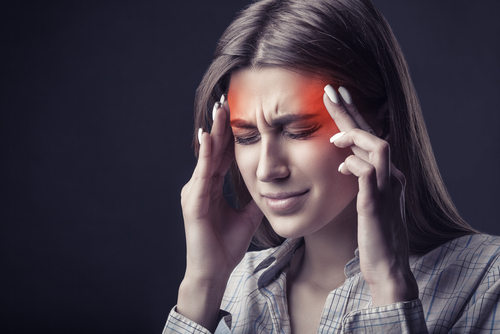Cluster headaches occur in cyclical patterns or clusters and are one of the most painful types of headaches affecting 1 to 2 people in every 1,000. These cluster headaches are a series of very short, but extremely painful, headaches lasting anywhere from 15 to 180 minutes and occur every day for weeks or up to months at a time. This headache disorder consists of severe headaches focused on one side of the head with flushing or sweating of the face, red or teary eyes, runny or stuffy nose, or a sense of restlessness and agitation.
This headache disorder consists of severe headaches focused on one side of the head with flushing or sweating of the face, red or teary eyes, runny or stuffy nose, or a sense of restlessness and agitation. “Episodic” cluster headaches are diagnosed as such when the attack happens in periods lasting anywhere from 7 days to one year with a separation of pain-free periods lasting for one month or longer. For “chronic” cluster headaches, the attacks occur for more than one year without any remission or with a remission lasting less than a month. Out of those who experience cluster headaches, 80% have the episodic cluster headaches.
Are You Experiencing Migraine Clusters or Cluster Headaches?
Quite often, cluster headaches could be confused with migraine clusters. The differences between cluster headaches and migraine clusters are the following:
Migraine Clusters:
- Throbbing or pulsing sensation
- Sensitivity to light and sound
- Nausea
Before a migraine hits, one could experience neck stiffness, constipation, change in mood, and increased thirst. Cluster headaches will usually occur in cycles of weeks or months and are extremely painful with pain located on one side of the head. Cluster headaches also do not last as long as migraines do, in which migraines can last for hours at a time (4 hours) while cluster headaches happen shortly in clusters (“in and out”).
When it comes to men and women, women tend to get migraines more than men while men are much likelier than women to experience cluster headaches. In addition, hormones seem to have a role in causing migraines while there is very little known about the cause of cluster headaches. Migraine sufferers also prefer to go into quiet, dark rooms, while experiencing a migraine whereas people with cluster headaches become agitated and unable to keep still.
Symptoms of Cluster Headaches
When having a cluster headache attack the pain is severe, unilateral (on one side of the head), and either orbital (near the orbit, the bone framing the eye), supraorbital (above the orbit bone), temporal (at the temple) or a combination of these areas and sometimes the pain moves towards the back of the head.
On the same side of the pain, you may have one or more of these symptoms occur:
- Drooping eyelid (ptosis)
- Nasal Congestion
- Runny nose (rhinorrhea)
- Eyelid swelling (edema)
- Red eye (conjunctival injection)
- Tearing (lacrimation)
- Sweating on the face or forehead
- Abnormally small pupil size (miosis)
Effective Treatment for Cluster Headaches?
Since the cause is unknown, most treatments for cluster headaches are only to alleviate your symptoms, such as injections, prescription medications, nasal spray with pain reliever, preventive medication (used to stop headaches before they start and to shorten the length and lessen the severity of cluster headache attacks), oxygen (breathed in through a face mask for 15 minutes), and surgery if nothing else has worked. Most surgical procedures involve blocking your trigeminal nerve. The trigeminal nerve controls the area around the eye and is a main pathway for pain. However, if a mishap occurs with trying to block your trigeminal nerve it can cause weakness in the jaw and a loss of sensation in your head and face.
Other than surgical procedures, other treatments are used to hide your symptoms. None of the treatments above go after the direct cause, but only work to stop the pain from occurring. This is when upper cervical treatments shine the most for those who want more than pain relief. Upper cervical doctors focus on the top two vertebrae of your spine that house the brain stem. When any of these top two vertebrae are misaligned, they affect the brain stem’s functions which can send you mixed signals all throughout your body. Upper cervical adjustments exist to correct the atlas and the axis (the top two vertebrae) to ensure your brain stem is functioning normally.
In any case your upper cervical bones are aligned, your brain stem is greatly affected and can end up doing the following: disrupt brain to body communication, affect breathing, change blood pressure, raise heart rate, send painful signals when there is no pain, disturb digestion, and more automatic body functions. These changes can create many different kinds of chronic pain and conditions, including cluster headaches and migraines. When the brain stem is compressed, which happens when a misalignment occurs, the change in blood circulation can create headaches while other pinched nerves inside of the brain stem trigger pain. Many patients with headache clusters find relief after adjustments correct their upper cervical area, releasing pressure off their brain stem and allowing their body to function and send signals normally.
By allowing your brain stem to function as it should, your body regains the ability to heal itself naturally and do its best to get everything back to normal, helping you find relief and an effective way to tackle the main cause of your pain without medication or surgery. For those struggling with cluster headaches, it is highly recommended they try an all-natural treatment before medication or surgery as both can have negative and threatening side effects.

